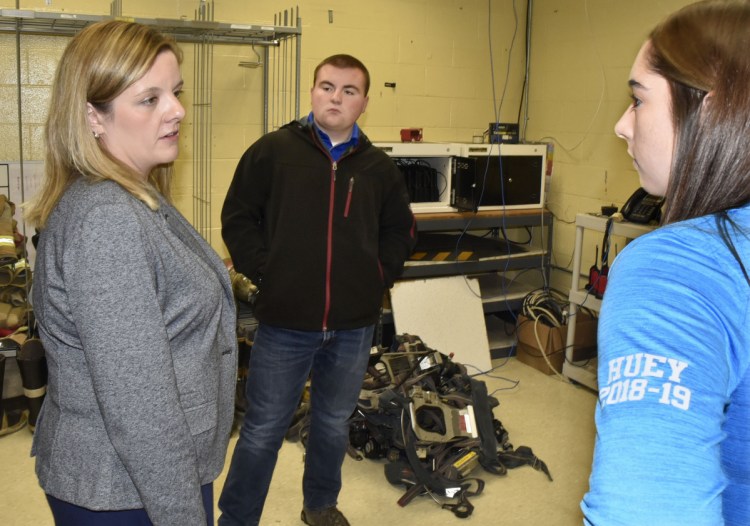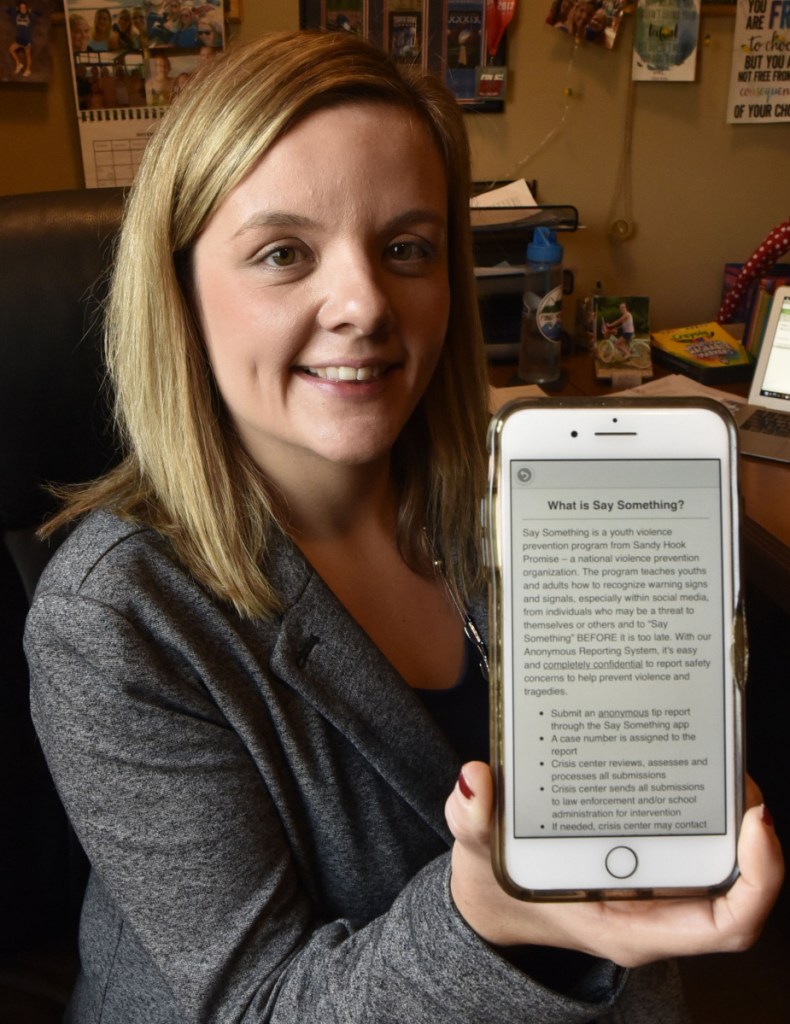WATERVILLE — While gun violence in schools has devastated many communities in recent years, the Waterville area hasn’t had any problems yet, and administrators are taking precautions to keep it that way.
By the spring of 2019, Beth Carlton, student services coordinator at Mid-Maine Technical Center, hopes to introduce an anonymous reporting system called Say Something to students at the technical center as well as at Waterville and Winslow junior high and high schools. Parents, teachers and administrators will also be able to use the system.
Say Something is an offshoot of Sandy Hook Promise, a national nonprofit organization formed by families of the 26 victims from the 2012 Sandy Hook Elementary School massacre. The program trains kids to recognize and speak up about potential threats posed by peers, especially on social media. Students in participating districts can submit tips about suspicious behavior through a Say Something smartphone app, website or 24/7 hotline without having to disclose their identity and fear facing social or physical consequences. A Say Something crisis counselor then gathers more information from the student, determines whether the situation is life-threatening or not and works with officials from the school and local law enforcement to respond accordingly.
“Some people ask, ‘Why do we need this? Kids can just tell teachers or the police,'” Carlton said. “But they’re not. We need another way. With increases in stress, anxiety and mental health issues, we need to do something to prevent anything from happening.”
According to the Sandy Hook Promise website, research from the Secret Service found that 81 percent of violent school attacks involved at least one person who knew about the perpetrator’s plans but did not take action.
The anonymous reporting system was introduced across the country in March 2017. While the overarching organization was initially formed in 2013 to curb school shootings, Say Something gives students an outlet to report abuse, bullying, depression, fighting, substance abuse, suicide threats, any discussion about weapons and any threats of violence toward a school, one’s self or another person.
RSU 21 LEADS THE WAY
Say Something is free of charge for participating schools. Two other school districts in Maine are in the process of rolling out the anonymous reporting system, according to Stephanie Morris, who does public relations work for Sandy Hook Promise. Regional School Unit 21, which includes the towns of Arundel, Kennebunk and Kennebunkport, started using the program Nov. 7. Regional School Unit 57, which includes the towns of Alfred, Limerick, Lyman, Newfield, Shapleigh and Waterboro, will implement the program in December, Morris said. Nationally, 152 school districts in 25 states currently use or are preparing to use the reporting system.
Massachusetts’ attorney general office recently received a $1 million grant from the Department of Justice to put Say Something and other violence prevention programs in place at schools throughout the state. In January 2019, 508 districts in Pennsylvania will implement the system after the state’s Office of the Attorney General agreed to partner with Sandy Hook Promise.
Katie Hawes, RSU 21’s superintendent, said that Say Something has already made positive impacts on the six schools in the district. In the two weeks that it has been live, she said that 25 tips have come through, 11 of which were categorized as “life-safety,” meaning the risks are more immediate. Most have been reported in the evening or early morning, according to Hawes.
“We were surprised at how quickly we started getting tips,” Hawes said. “Our kids are taking it very seriously. They’re not sending jokes.”
Hawes noted that each of the 11 urgent tips involved students whom the district has “already been working with and watching pretty closely.” One person used the system to voice concern about a student in another district and was able to get that person help even though their high school is not registered with Say Something.
“Parents have been very appreciative, especially involving life-safety calls,” Hawes said. “The reaction has been, ‘Thank you so much for implementing this and making sure our kids are safe.'”
STEPPING IN BEFORE SOMETHING HAPPENS
Nicole Hockley, a co-founder and managing director of Sandy Hook Promise, stressed the importance of teaching students to take note of signs that an individual may cause harm. Hockley lost her 6-year-old son, Dylan, in the Sandy Hook attack.
“(Social media) is more often than not the chosen way that a lot of kids are putting out their anxiety, their depression and their subtle — or very overt — threats,” she said. “But the problem is that if we’re not teaching our kids how to recognize that for what it is and take it seriously, then that’s when we get a lot of people who don’t say something, and then after the fact say, ‘Oh my gosh, he said that he was gonna do that,’ or, ‘I thought that was gonna happen.’ It’s teaching people to lean in and say, ‘Something’s wrong there. That person needs help,’ and taking action to get an intervention made.”
Winslow superintendent Peter Thiboutot said he has not been made aware of any serious threats of danger at Winslow schools recently, but that adding protective measures — especially at no cost — will only benefit the community.
“There are already things in place (for safety) — doorbells, cameras, a philosophy of working with kids to make them feel like they belong here,” he said. “This is just one added piece to help students if they feel like something’s not quite right.”
Currently, to report suspicious behavior, students or parents must tell a teacher or administrator, who then addresses the concern with the appropriate personnel, which can sometimes include law enforcement, according to Thiboutot.
Waterville superintendent Eric Haley could not be reached for comment.
GETTING STARTED IN WATERVILLE, WINSLOW
Carlton said she heard of Sandy Hook Promise at a conference last fall and came across the Say Something system after browsing the organization’s website. Sandy Hook Promise offers several other school violence and suicide prevention programs and guides. Carlton will be the lead administrator for the program in Waterville and Winslow.
“I’m really excited to do it because I think everyone is looking for ways to help prevent school violence,” she said. “It’s great for the staff to have another option, students to have a voice and parents to feel comfortable that we’re doing everything we can to keep people safe.”
Before it gets rolled out, Carlton will receive several hours of training from the nonprofit. Teachers, counselors, administrators and other members of the school crisis teams, as well as dispatchers at the Waterville police communications center, will also receive training before students are taught to use the system at an assembly.
“Just that assembly alone might put up a roadblock in someone’s mind (to stop them from) doing anything,” said Winslow school board member John Ferry. “They may think that now that there’s an option if my fellow students think I might be a threat — it might be a deterrent as well.”
Hawes said that the only negative feedback she has heard about the system at RSU 21 was that roughly 10 sixth graders out of about 200 in the class “were very emotional after the training.”
“Sixth graders are really young, and this content is hard,” Hawes said. “We’re going to be a little more proactive on the front end about what the content is and have parents talk to their children beforehand.”
Hockley would not directly comment on any pushback that Say Something or Sandy Hook Promise has received from national gun-rights groups like the National Rifle Association.
“Our programs (have) been universally praised across the country,” she said. “Schools, communities and youth organizations in every state — whether red, blue or purple — have adopted and implemented our programs. At the end of the day, we all have the same goal: keeping kids safe from gun violence.”
POLICE INVOLVEMENT
Hawes said that the York County Sheriff’s Office, two dispatch centers and three police departments that work with RSU 21 have been “wonderfully supportive all the way through” as her school district rolled out the system. Carlton said that the Waterville police department has expressed similar attitudes and noted that it would “absolutely make it work.”
Waterville School Resource Officer Linda Smedberg, who will be involved with the law enforcement side of Say Something, said the police department is still in the early phases of working with schools and Sandy Hook Promise on rolling the reporting system out.
“(The Waterville police department) has been very receptive to the program,” said Smedberg. “Even knowing that there would be some training involved, they’re very receptive to that too, and we think it would be beneficial and worth whatever time we’d have to put in.”
Law enforcement only deals with life-safety cases. In these scenarios, officers are dispatched to do wellness checks on the children.
“Basically, they just go wake the parents up and say: Where are they? Is the kid OK? Are there firearms in the house? What can we do to make sure everyone’s OK? And then we follow up in the future,” Hawes said.
She added that having an outlet for students to report issues off-hours is encouraging.
“We’re not there on Friday at midnight, so if (someone is) on Snapchat with a friend of theirs and has reason for concern, we may not have heard about that until Monday, but the police can go do a well child check,” Hawes said.
All crisis counselors who serve as the direct answering points for Say Something tips have undergraduate degrees and at least three to five years of professional experience. The counselors work out of a facility in North Miami that also acts as an answering point for other agencies.
‘MORE DEMAND THAN WE CAN RESOURCE’
Carlton said that the process of putting the system in place at Waterville and Winslow schools has been slow but is gaining momentum.
“It’s taking a while because the interest in this program nationally is so large that the wait time to get on-boarded is so long,” she said. “I just got connected with an on-boarding person (Tuesday), and now I’m waiting to hear back from him.”
Hockley spoke to this point.
“We do have much more demand for our services than we can currently resource, but we’re also being careful about how we grow because we view these programs, rightly so, as a matter of life and death for someone,” she said. “We couldn’t do every single school in the country year one because we want to make sure that what we’re doing has fidelity and control and is the highest quality program possible.”
Hawes said it took eight months for the system to go live in RSU 21 schools after the district initially reached out to Sandy Hook Promise in March.
EYEING THE FUTURE
Hockley added that in today’s climate, the importance of having resources like Say Something in place is essential.
“People need to know that these acts of violence are preventable, and when we know the signs and how to recognize them, then we can take action and help before a tragedy happens,” she said. “With so much focus on school security and imminent danger, I think sometimes people forget that it’s much more effective to stop something from ever happening in the first place.”
Hawes likened it to other public safety programs that have emerged over the years.
“‘See something, say something’ is much like the whole ‘Don’t drink and drive, arrive alive’ thing,” she said. “In the ’80s, a lot of people drank and drove. Now, that’s taboo. If we can teach kids the difference between tattling … and preventing (violence), then hopefully we change society’s view about this.”
Meg Robbins — 861-9239
Twitter: @megrobbins
Send questions/comments to the editors.





Comments are no longer available on this story